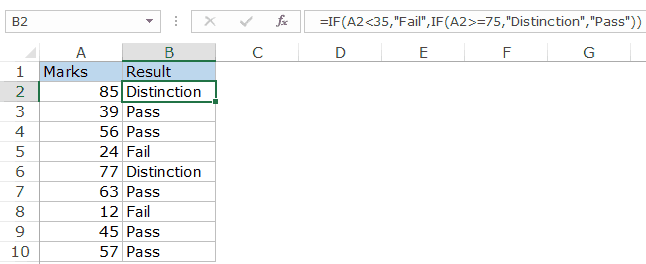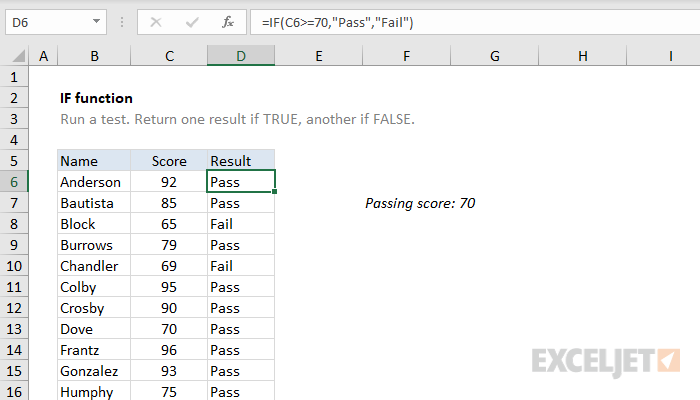The 9-Minute Rule for Excel If Statements
The function informs the spread sheet the sort of formula. If a math function is being done, the mathematics formula is surrounded in parentheses. Using the array of cells for a formula. For example, A 1: A 10 is cells A 1 via A 10. Formulas are created making use of absolute cell reference.

In our first formula participated in the cell "D 1," we by hand go into a =amount formula to include 1 +2 (in cells A 1 as well as B 2) to get the total of "3." With the next example, we make use of the highlight cells A 2 to D 2 and also then as opposed to inputting the formula use the formula switch in Excel to automatically produce the formula.
Lastly, we by hand go into a times (*) formula utilizing amount feature to find the worth of 5 * 100. Keep in mind The features detailed below may not be the exact same in all languages of Microsoft Excel. All these instances are carried out in the English variation of Microsoft Excel. Idea The instances listed below are provided in indexed order, if you intend to begin with one of the most usual formula, we recommend starting with the =AMOUNT formula.

=AVERAGE(X: X) Display the ordinary amount in between cells. For instance, if you desired to obtain the standard for cells A 1 to A 30, you would certainly type: =AVERAGE(A 1: A 30). =MATTER(X: X) =COUNTA(X: X) Count the number of cells in a range that consist of any type of message (text and numbers, not just numbers) and are not vacant.
Indicators on Excel If Formula You Should Know
If 7 cells were vacant, the number "13" would be returned. =COUNTIF(X: X,"*") Count the cells that have a specific value. For instance, if you have =COUNTIF(A 1: A 10,"EXAMINATION") in cell A 11, then any type of cell in between A 1 with A 10 that has words "examination" will be counted as one.
As an example, the formula =IF(A 1="","SPACE","NOT BLANK") makes any type of cell besides A 1 state "SPACE" if A 1 had nothing within it. If A 1 is not empty, the other cells will certainly review "NOT BLANK". The IF declaration has more complex uses, however can normally be decreased to the above framework.
As an example, you may be separating the worths between 2 cells. Nonetheless, if there is nothing in the cells you would certainly get the =INDIRECT("A"&"2") Returns a reference specified by a text string. In the above example, the formula would return the worth of the cell contained in A 2.
=TYPICAL(A 1: A 7) Locate the average of the worths of cells A 1 via A 7. For instance, four is the mean for 1, 2, 3, 4, 5, 6, 7. =MIN/MAX(X: X) Minutes and Max stand for the minimum or maximum quantity in the cells. For instance, if you desired to obtain the minimum worth between cells A 1 and A 30 you would place =MIN(A 1: A 30) or if you desired to obtain the optimum concerning =MAX(A 1: A 30).
Some Known Details About Excel If Function Multiple Conditions
For instance, =Product(A 1: A 30) would numerous all cells with each other, so A 1 * A 2 * A 3, and so on =RAND() Produces an arbitrary number above no yet much less than one. For instance, "0.681359187" can be a randomly generated number placed into the cell of the formula. =RANDBETWEEN(1,100) Generate a random number between 2 values.
=ROUND(X, Y) Round a number to a specific variety of decimal locations. X is the Excel cell consisting of the number to be rounded. Y is the number of decimal locations to round. Below are some examples. =ROUND(A 2,2) Rounds the number in cell A 2 to one decimal place. If the number is 4.7369, the above example would round that number to 4.74.
=ROUND(A 2,0) Beats the number in cell A 2 to absolutely no decimal locations, or the local digit. If the number is 4.736, the above example would round that number to 5. If the number is 4.367, it would certainly round to 4. =SUM(X: X) The most generally made use of feature to add, subtract, numerous, or divide values in cells.
=AMOUNT(A 1+A 2) Add the cells A 1 as well as A 2. =SUM(A 1: A 5) Include cells A 1 through A 5. =AMOUNT(A 1, A 2, A 5) Adds cells A 1, A 2, and also A 5. =SUM(A 2-A 1) Subtract cell A 1 from A 2. =AMOUNT(A 1 * A 2) Multiply cells A 1 and A 2.

Rumored Buzz on Excel If Statement
=SUMIF(X: X,"*"X: X) Perform the AMOUNT feature only if there is a specified worth in the very first chosen cells. An example of this would certainly be =SUMIF(A 1: A 6,"EXAMINATION", B 1: B 6) which only includes the values B 1: B 6 if words "examination" was placed someplace in between A 1: A 6. So if you put TEST (not instance delicate) in A 1, but had numbers in B 1 with B 6, it would only include the worth in B 1 due to the fact that TEST remains in A 1.

=TODAY() Would certainly print out the current day in the cell gotten in. The value will certainly change each time you open your spreadsheet, to reflect the existing date and time. If you intend to enter a date that does not transform, hold back semicolon) to enter the date. =PATTERN(X: X) To locate the typical worth of cell.
=VLOOKUP(X, X: X, X, X) The lookup, hlookup, or vlookup formula enables you to browse as well as locate related values for returned outcomes. See our lookup definition for a full meaning and complete information on this formula. .
Each IF function in an Excel spread sheet returns one of two messages. The very first-- the "if" message-- shows if cells satisfy criteria that you define. The second-- the "or else" message-- displays if they do not. As an example, mean that your sheet tracks the hrs that each of your workers works.
excel if formula based on drop down list if formula excel power query excel if formula not zero